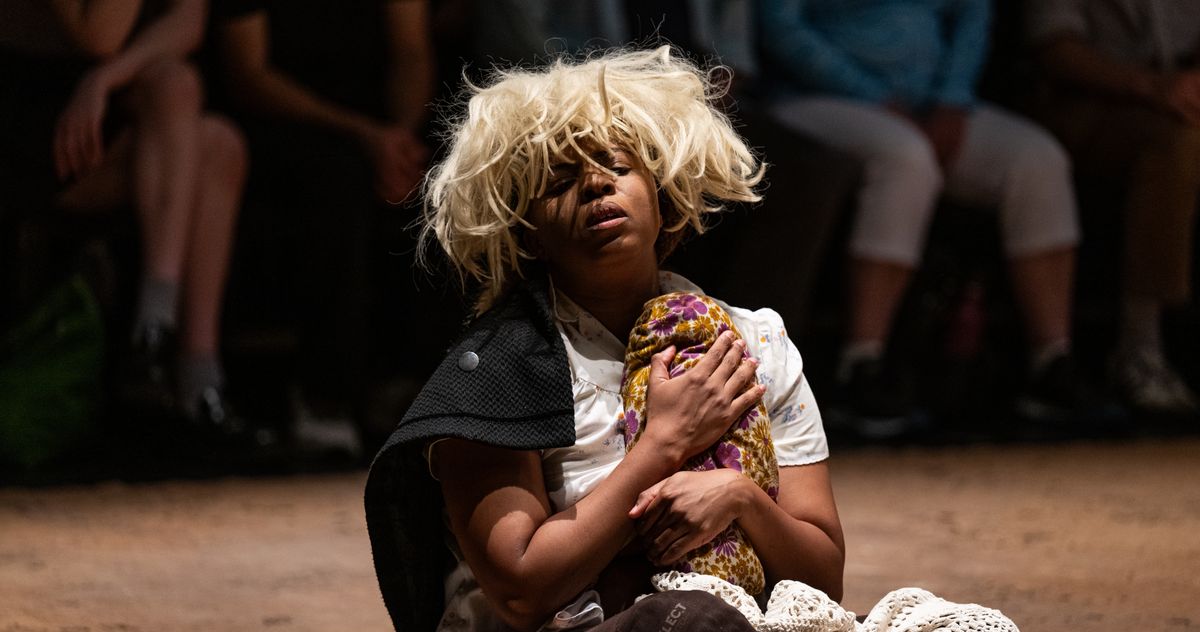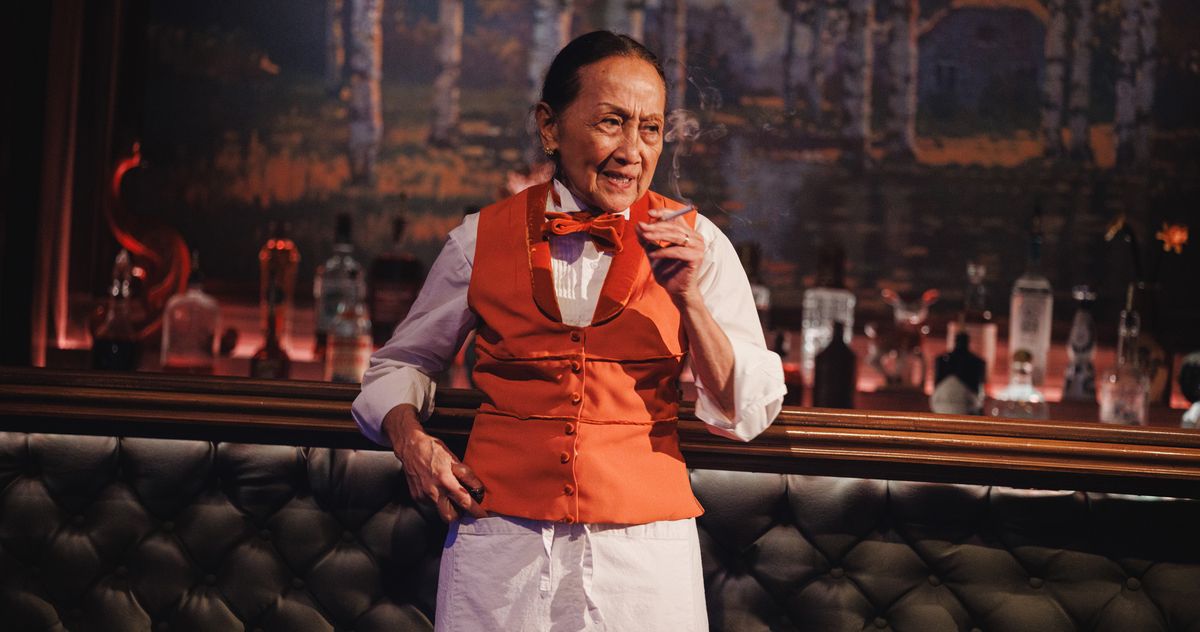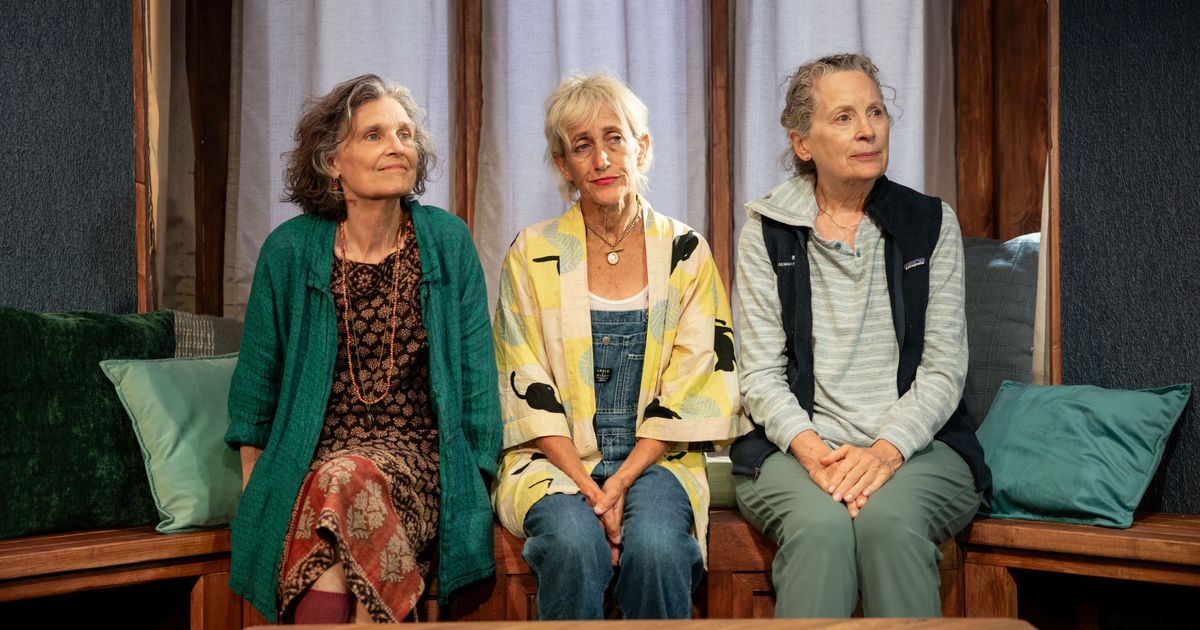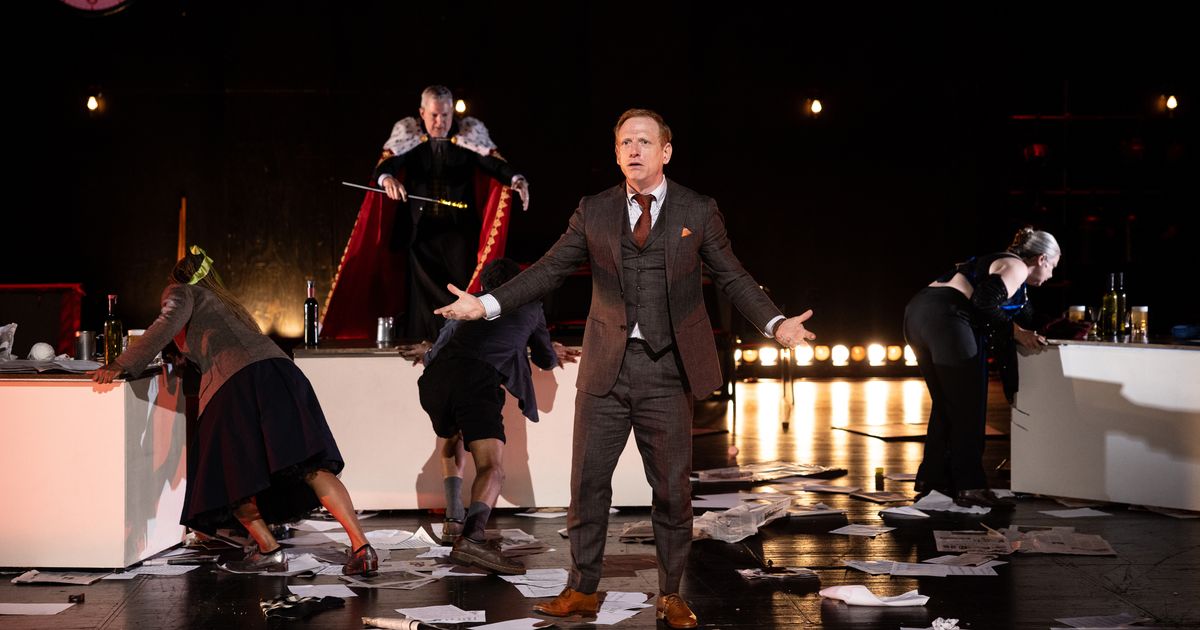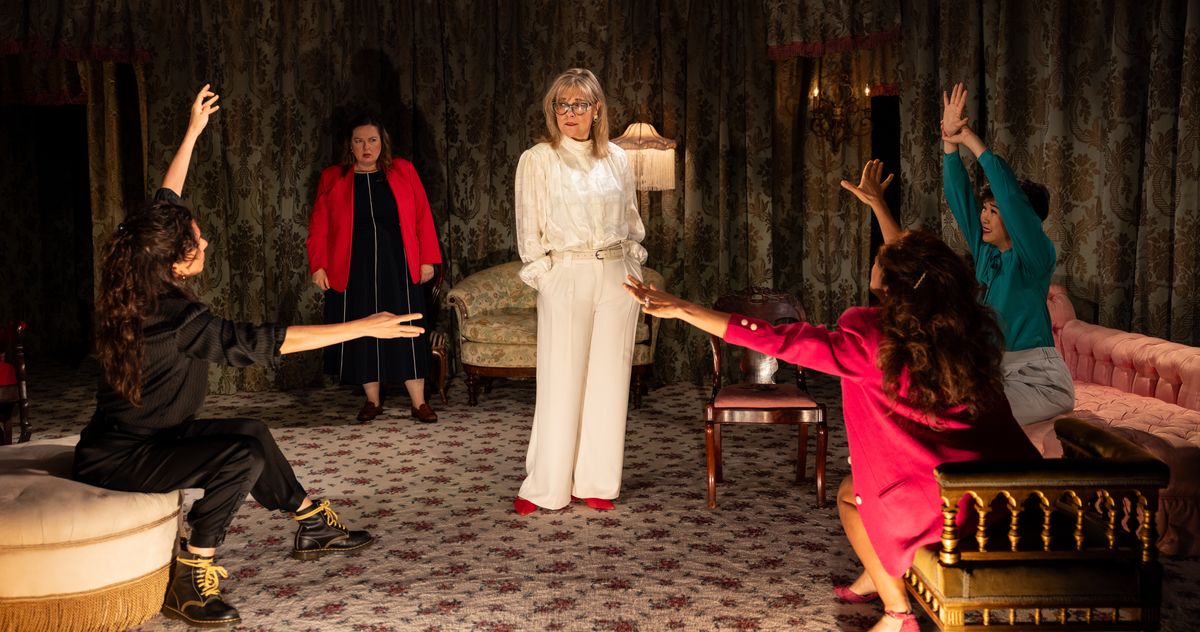A little more than five years ago, audiences at St. Ann’s Warehouse eyed each other across a long, sparse playing space, its neutral brown evoking the rolling plains and dusty mainstreets of an America in the final throes of westward expansion. Now, at the same theater, inside a similar scenic container, the Danish director Tue Biering and the South African theater-maker Nhlanhla Mahlangu are taking playgoers back to the old West for another reconsideration of foundational American myths. The co-directors of Dark Noon can’t help it that shades of Daniel Fish’s “sexy”—and, more to the point, thrillingly, profoundly revisionist—Oklahoma! still haunt this particular venue. But the fact that their own thematically comparable show contributes so little of substance to the same grand, gnarly conversation is their pig and their farm. Dark Noon aims to peel the romantic, heroic, white-and-European mask from the hoary historical narrative of Manifest Destiny, but not only does it feel late to the party—that mask has already rotted away—but it also shows up with mostly truisms to offer.
At least it starts out strong: As the theater darkens, Biering and Mahlangu’s ensemble—all South African actors—stride down the sides of the space. Silhouetted at a stand mic, one of them whistles ominously. We know that whistle, just as we know the hulking shapes two other performers make as they step toward each other. A fourth actor rolls across the stage in a ball — a human tumbleweed. No one’s wearing spurs, but in our minds we can hear them clinking. There’s an approach, a turn, ten paces, and then, BANG. It’s a promising beginning for a show that describes itself as a “subversive reimagining” of history through “an outsider’s view of Hollywood westerns.” Then people start talking. “Once upon a time in the middle of the 1800s,” says another actor, Lillian Tshabalala-Malulyck, as she dons a blonde wig and stares into a live-feed camera, her face blown up on a screen at one end of the stage, “far far away from South Africa, on the continent called Europe, there was a huge crisis of hunger and poverty. Most of the Europeans were starving, and were very poor. I know, I know — ‘poor white people’? It’s hard for me to imagine too, but work with me here.”
This is the kind of storytelling, and the level of complexity and humor, Dark Noon will employ throughout. Its seven actors, six Black and one white, soon join Tshabalala-Malulyck in their own garish yellow wigs, covering their faces with white powder to portray a brutal and dim-witted parade of settlers, pioneers, and cowboys. (These loaded labels are specifically called out and defined in the course of the show.) It feels important to note that Biering, the European in the room, wrote the script, while his co-director Mahlangu handles the show’s choreography, which is, by contrast, often more compelling if only by virtue of being more fluid and ambiguous. In limited moments, the actors speak in untranslated Zulu, and something new and potent is released into the room. But, when they return to English, the majority of the play’s text veers ironic and simplistic, like an “edgy” term paper by someone who’s excited for us to know that he not only read Guns, Germs, and Steel but also found it problematic. I often wondered what Dark Noon would have been like as a piece of pure movement—a fuller dance with Johan Kølkjær’s exciting set, where a scrappy frontier town is assembled as if out of Lincoln Logs—or if the creators hadn’t chosen English as their production’s principal language.
“Violence had become a part of their DNA,” says Tshabalala-Malulyck’s narrator around the show’s halfway point. The pioneers, she says, “had spent all their lives fighting, and violence was now their primary form of communication. It was in their nature. The only way they knew how to behave was through exercising power.” If this is in earnest, I call bullshit, and if it isn’t, why should we care? In its attempt to topple once-dominant narratives, Dark Noon participates in the same fallacies such narratives long relied on. The point of view has shifted but the temptation to speak in bulldozing generalizations—to dismiss entire populations as inherently backwards and violent—clings like a wet sock. In the mouths of the old white writers, this stuff readily presents itself as the facile, racist garbage that it was and is. And while flipping the script might render it hipper, it doesn’t make it less superficial. This isn’t “reverse racism,” which still isn’t a real thing. It’s just a shallow, boring way to think about people. Reaching for a more nuanced, specific view of those who came before us—more nuanced, even, than they themselves might have taken—isn’t ultimately a matter of their humanity, but our own — we owe it not to them but to ourselves.
Besides, the First Nations don’t come off much better here than the colonizers do. Every so often, Mandla Gaduka or Thulani Zwane show up wearing feathered headdresses and stoic expressions, and then get hollered at or locked up or shot (and shot and shot and shot) by the white folks. We’re so proud of ourselves for dispensing with the “savage” half of the nasty old trope; why is it so hard for us to let go of the “noble” half? Despite, we are told, the fact that the peoples who came across the Bering Strait thousands of years ago were “complex and diverse … for all their differences, one belief held true — that no one could own the land.” This might be broadly accurate, and certainly it presents a clear and convenient set of progressive values with which to align ourselves (in case we were confused over the moral fiber of the pillaging, raping settlers) — but again, it’s too easy. Hundreds of years before covered wagons, cowboys, and even Columbus, the city-state of Cahokia—in the twelfth century, the biggest New World metropolis north of Mexico—had already risen, expanded, moved toward a variety of hierarchical practices that sure looked a lot like enclosure and eminent domain, then declined and collapsed. Among plenty of fascinating anthropological examples, Cahokia’s existence serves as proof that people and cultures are rarely pure and never simple.
But Dark Noon is happy to keep things straightforward — so straightforward, in fact, that the show often feels less researched than brainstormed. What do we all think the American old West was like? More precisely and intentionally embraced, such a question could make for its own intriguing play — to wit, Anne Washburn’s brilliant Mr. Burns, a Post-Electric Play, where the characters sit around their after-the-apocalypse campfire attempting to reconstruct Simpsons episodes from memory. But Dark Noon doesn’t signal that this kind of deliberately fuzzy private mythmaking is the heart of its project. At least not until its very end — I won’t spoil the details, but in the show’s finale, the masks come off, and suddenly Dark Noon becomes, for a few minutes at least, sharply personal and compelling. How much does it matter, though, when what’s come before is nearly two intermissionless hours of generalized burlesque? When, for instance, Tshabalala-Malulyck tells the story of Sam Brannan, the man who started the Gold Rush, her jokey recitation of events reads not as, on some level, self-aware but simply glib: “Now, I’d like to imagine that Sam was probably chilling in his store one day and he realized how boring his life was and so he heard a voice from above. A voice of God, if you will. That said, ‘Sam? … Your life is boring. How about I show you some precious shiny stone to make you rich?’”
This campy tone is calculated, but that doesn’t make it work. In an interview with the British Theatre Guide podcast, Mahlangu described Dark Noon as a riposte to centuries of “African history being written by a European gaze … We are inverting this thing,” he said. “This is what it looks like when you are writing someone else’s history. Can you see how ridiculous it looks? That is why we are so ridiculous when we are inside the world of Dark Noon. The idea of overtly waking up and thinking you deserve everything that is in the hands of someone else, and that kind of psychosis of thinking.” There’s a conceptual neatness to Mahlangu’s analysis: Not only did you kill us and steal from us; then you cast us as beasts and fools in your stories, so now we’ll return the favor. But just turning the tables of narrative power isn’t enough to create a nuanced, revelatory piece of art. It leaves a void in the center of the room, a dull gap where theatrical and historical events that should shake us, shock us, only leave us thinking, “Well… And then?”
In the tiny upstairs theater at the Connelly, another experiment in rebalancing power is taking place. Marin Ireland, extraordinary as an actor, has written a play in which very real events from her own life are receiving if not a public exorcism—such final catharsis may never be possible—then a kind of communal witnessing and processing, a long overdue ritual of acknowledgement.
For more than a decade, the theater world has carried around the disturbing half-secret that while Ireland was in a relationship with the actor Scott Shepherd, Shepherd hit her during an argument, giving her a black eye. It was talked about—the Times weighed in, as did people who found the Times coverage skewed and distressing—but this was pre-Me Too, and no one really knew how to handle the ugly, sticky facts. As Ireland’s thoughtful, painful Pre-Existing Condition makes excruciatingly clear, we still don’t. “We are too fucking liberal for this shit,” says one of the characters, known only as “D” (played, when I saw the show, by Gregory Connors, understudying for Greg Keller and hitting a home run). The play’s four figures are designated by letters, A through D. A, the authorial avatar, is navigating the traumatic aftermath of an abusive event and the ensuing break-up; B (Dael Orlandersmith), C (the excellent Sarah Steele), and D flow in and out of her orbit as friends, therapists, moderators of a domestic violence support group, lawyers, family members, and tentative first dates. Director Maria Dizzia keeps the action spare and elegant, with Isabella Byrd’s precise, subtle lighting fluently shifting our focus and our interpretation of the neutral playing space.

Central to Pre-Existing Condition’s concept is that the role of A will be played by several different actors during the show’s run. Eventually Dizzia herself will step in, taking up the spiral-bound script that A carries throughout the show, signaling both the character’s shared nature and the crucial, physicalized retention of her own story. So will Julia Chan, Deirdre O’Connell, and Tavi Gevinson. I saw Tatiana Maslaney—utterly raw and wrenching without overplaying a note—and though there’s certainly a celebrity factor in this rotating casting, it also serves other, more meaningful purposes. There is, in the whole company of Pre-Existing Condition and most concertedly in the group of A’s, a communal solidarity with Ireland being explicitly offered. There’s also the implication—or rather the demonstrable truth—that A could be anyone, of any age. One in three women, the show reminds us, experiences abuse. One in three worlds has been broken and must be slowly reassembled, day by day and moment by moment. A is everywhere.
“I mean, like, what do you want?” people keep asking A. “Do you want revenge or something?”; “You should probably just move on. Let it go”; “It’s still really consuming you.” Part of Ireland’s insight as a writer is that these questions, these observations, even when they sting or feel bluntly insensitive, are never played for cheap laughs. There’s humor in Pre-Existing Condition, but not at the expense of the people A interacts with, even when they’re guys who say things like, “Can I ask you something, like, as a woman? … Like would you rather have a guy who’s just not aggressive, like, ever?” A—and Ireland—may well be trying to regain some sense of her own power, but her project isn’t retributive. It’s a search, not a solid answer but a series of questions. “What the fuck do I do with this?” A asks herself. She’s aware, deep in her gut, that the looming shadow isn’t actually her abuser, but the feelings of worthlessness to which he kicked open the door. “It’s not about him. It’s about you,” says B as A’s therapist. Even more penetrating is C as a younger friend of A’s who looks up to her artistically. When, on a coffee catch-up, A mumbles that she doesn’t “really feel that successful,” C blinks with smiling incredulity. “Like, is this sort of a thing with you?” she asks brightly, “Not valuing your achievements?”
Maslaney is heartbreaking at the center of Ireland’s story; you can see her body, sometimes tensely twisted and sometimes crumpled in dull exhaustion, working through a poison it’s trying to expel. Whatever Dizzia, Chan, O’Connell, and Gevinson bring to the role, there’s a sense that they’ll be bolstered by Maslaney’s performance, and that she in turn is drawing strength from the knowledge that they’re right behind her. “You have some nice friends,” Connors’s D tells A at one point. Perhaps that’s what you do with this: Find those friends, take their hands, tell your story.
Dark Noon is at St. Ann’s Warehouse through July 7.
Pre-Existing Condition is at the Connelly Theater Upstairs through August 3.
Related




